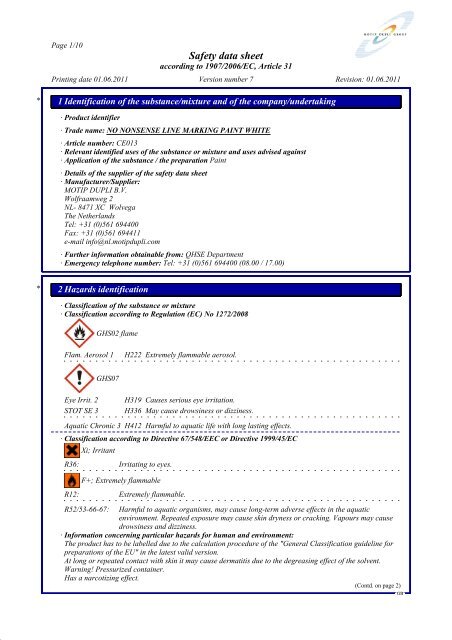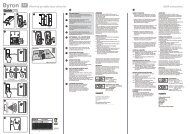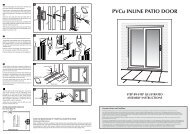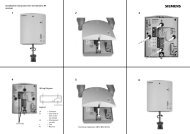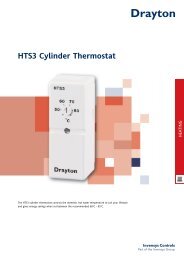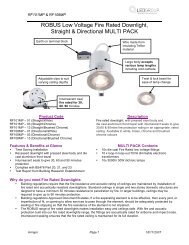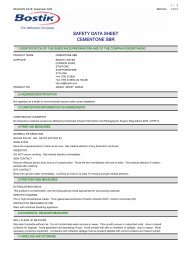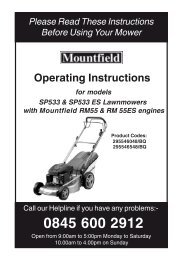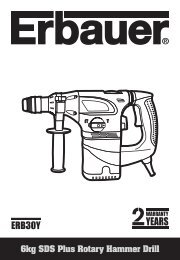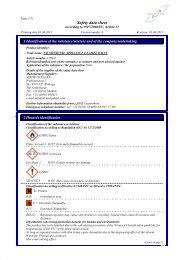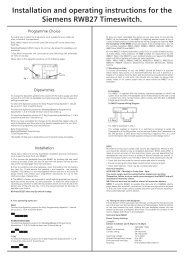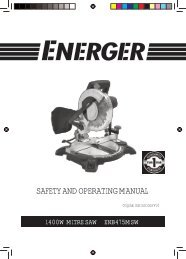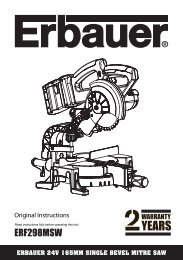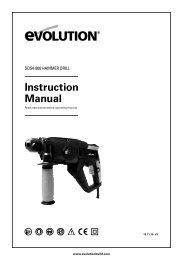Safety data sheet - Free-Instruction-Manuals.com
Safety data sheet - Free-Instruction-Manuals.com
Safety data sheet - Free-Instruction-Manuals.com
Create successful ePaper yourself
Turn your PDF publications into a flip-book with our unique Google optimized e-Paper software.
DR<br />
Page 1/10<br />
<strong>Safety</strong> <strong>data</strong> <strong>sheet</strong><br />
according to 1907/2006/EC, Article 31<br />
Printing date 01.06.2011 Version number 7<br />
Revision: 01.06.2011<br />
* 1 Identification of the substance/mixture and of the <strong>com</strong>pany/undertaking<br />
· Product identifier<br />
· Trade name: NO NONSENSE LINE MARKING PAINT WHITE<br />
· Article number: CE013<br />
· Relevant identified uses of the substance or mixture and uses advised against<br />
· Application of the substance / the preparation Paint<br />
· Details of the supplier of the safety <strong>data</strong> <strong>sheet</strong><br />
· Manufacturer/Supplier:<br />
MOTIP DUPLI B.V.<br />
Wolfraamweg 2<br />
NL- 8471 XC Wolvega<br />
The Netherlands<br />
Tel: +31 (0)561 694400<br />
Fax: +31 (0)561 694411<br />
e-mail info@nl.motipdupli.<strong>com</strong><br />
· Further information obtainable from: QHSE Department<br />
· Emergency telephone number: Tel: +31 (0)561 694400 (08.00 / 17.00)<br />
* 2 Hazards identification<br />
· Classification of the substance or mixture<br />
· Classification according to Regulation (EC) No 1272/2008<br />
GHS02 flame<br />
Flam. Aerosol 1 H222 Extremely flammable aerosol.<br />
GHS07<br />
Eye Irrit. 2 H319 Causes serious eye irritation.<br />
STOT SE 3 H336 May cause drowsiness or dizziness.<br />
Aquatic Chronic 3 H412 Harmful to aquatic life with long lasting effects.<br />
· Classification according to Directive 67/548/EEC or Directive 1999/45/EC<br />
Xi; Irritant<br />
R36: Irritating to eyes.<br />
F+; Extremely flammable<br />
R12: Extremely flammable.<br />
R52/53-66-67: Harmful to aquatic organisms, may cause long-term adverse effects in the aquatic<br />
environment. Repeated exposure may cause skin dryness or cracking. Vapours may cause<br />
drowsiness and dizziness.<br />
· Information concerning particular hazards for human and environment:<br />
The product has to be labelled due to the calculation procedure of the "General Classification guideline for<br />
preparations of the EU" in the latest valid version.<br />
At long or repeated contact with skin it may cause dermatitis due to the degreasing effect of the solvent.<br />
Warning! Pressurized container.<br />
Has a narcotizing effect.<br />
(Contd. on page 2)<br />
GB
DR<br />
Page 2/10<br />
<strong>Safety</strong> <strong>data</strong> <strong>sheet</strong><br />
according to 1907/2006/EC, Article 31<br />
Printing date 01.06.2011 Version number 7<br />
Revision: 01.06.2011<br />
Trade name: NO NONSENSE LINE MARKING PAINT WHITE<br />
(Contd. of page 1)<br />
· Classification system:<br />
The classification is according to the latest editions of the EU-lists, and extended by <strong>com</strong>pany and literature<br />
<strong>data</strong>.<br />
· Label elements<br />
· Labelling according to EU guidelines:<br />
The product has been classified and marked in accordance with EU Directives / Ordinance on Hazardous<br />
Materials.<br />
· Code letter and hazard designation of product:<br />
Xi Irritant<br />
F+ Extremely flammable<br />
· Risk phrases:<br />
12 Extremely flammable.<br />
36 Irritating to eyes.<br />
52/53 Harmful to aquatic organisms, may cause long-term adverse effects in the aquatic environment.<br />
66 Repeated exposure may cause skin dryness or cracking.<br />
67 Vapours may cause drowsiness and dizziness.<br />
· <strong>Safety</strong> phrases:<br />
2 Keep out of the reach of children.<br />
16 Keep away from sources of ignition - No smoking.<br />
23 Do not breathe aerosol.<br />
26 In case of contact with eyes, rinse immediately with plenty of water and seek medical advice.<br />
29/56 Do not empty into drains, dispose of this material and its container at hazardous or special waste<br />
collection point.<br />
46 If swallowed, seek medical advice immediately and show this container or label.<br />
51 Use only in well-ventilated areas.<br />
· Special labelling of certain preparations:<br />
Pressurized container: protect from sunlight and do not expose to temperatures exceeding 50°C. Do not<br />
pierce or burn, even after use.<br />
Do not spray on a naked flame or any incandescent material.<br />
· Other hazards<br />
· Results of PBT and vPvB assessment<br />
· PBT: Not applicable.<br />
· vPvB: Not applicable.<br />
* 3 Composition/information on ingredients<br />
· Chemical characterization: Mixtures<br />
· Description: Mixture of substances listed below with nonhazardous additions.<br />
· Dangerous <strong>com</strong>ponents:<br />
CAS: 67-64-1<br />
EINECS: 200-662-2<br />
CAS: 107-98-2<br />
EINECS: 203-539-1<br />
acetone<br />
Xi R36<br />
F R11<br />
R66-67<br />
Flam. Liq. 2, H225<br />
Eye Irrit. 2, H319; STOT SE 3, H336<br />
1-methoxy-2-propanol<br />
R10-67<br />
Flam. Liq. 3, H226<br />
25-50%<br />
10-12.5%<br />
(Contd. on page 3)<br />
GB
DR<br />
Page 3/10<br />
<strong>Safety</strong> <strong>data</strong> <strong>sheet</strong><br />
according to 1907/2006/EC, Article 31<br />
Printing date 01.06.2011 Version number 7<br />
Revision: 01.06.2011<br />
Trade name: NO NONSENSE LINE MARKING PAINT WHITE<br />
CAS: 74-98-6<br />
EINECS: 200-827-9<br />
CAS: 111-76-2<br />
EINECS: 203-905-0<br />
CAS: 64742-95-6<br />
EINECS: 265-199-0<br />
CAS: 106-97-8<br />
EINECS: 203-448-7<br />
CAS: 75-28-5<br />
EINECS: 200-857-2<br />
propane<br />
F+ R12<br />
Flam. Gas 1, H220<br />
Press. Gas, H280<br />
2-butoxyethanol<br />
Xn R20/21/22<br />
Xi R36/38<br />
Acute Tox. 4, H302; Acute Tox. 4, H312; Acute Tox. 4, H332; Skin<br />
Irrit. 2, H315; Eye Irrit. 2, H319<br />
Solvent naphtha (petroleum), light arom.<br />
Xn R65<br />
Xi R37<br />
N R51/53<br />
R10-66-67<br />
Carc. Cat. 2, Muta. Cat. 2<br />
Flam. Liq. 3, H226<br />
Asp. Tox. 1, H304<br />
Aquatic Chronic 2, H411<br />
STOT SE 3, H335+H336<br />
butane<br />
F+ R12<br />
Flam. Gas 1, H220<br />
Press. Gas, H280<br />
isobutane<br />
F+ R12<br />
Flam. Gas 1, H220<br />
Press. Gas, H280<br />
· Additional information: For the wording of the listed risk phrases refer to section 16.<br />
* 4 First aid measures<br />
(Contd. of page 2)<br />
5-10%<br />
5-10%<br />
5-10%<br />
5-10%<br />
5-10%<br />
· Description of first aid measures<br />
· After inhalation: Supply fresh air; consult doctor in case of <strong>com</strong>plaints.<br />
· After skin contact: Generally the product does not irritate the skin.<br />
· After eye contact:<br />
Rinse opened eye for several minutes under running water. If symptoms persist, consult a doctor.<br />
· After swallowing: Drink plenty of water and provide fresh air. Call for a doctor immediately.<br />
· Information for doctor:<br />
· Most important symptoms and effects, both acute and delayed No further relevant information available.<br />
· Indication of any immediate medical attention and special treatment needed<br />
No further relevant information available.<br />
* 5 Firefighting measures<br />
· Extinguishing media<br />
· Suitable extinguishing agents:<br />
CO2, powder or water spray. Fight larger fires with water spray or alcohol resistant foam.<br />
· For safety reasons unsuitable extinguishing agents: Water with full jet<br />
· Special hazards arising from the substance or mixture No further relevant information available.<br />
· Advice for firefighters<br />
· Protective equipment: No special measures required.<br />
GB<br />
(Contd. on page 4)
DR<br />
Page 4/10<br />
<strong>Safety</strong> <strong>data</strong> <strong>sheet</strong><br />
according to 1907/2006/EC, Article 31<br />
Printing date 01.06.2011 Version number 7<br />
Revision: 01.06.2011<br />
Trade name: NO NONSENSE LINE MARKING PAINT WHITE<br />
* 6 Accidental release measures<br />
· Personal precautions, protective equipment and emergency procedures<br />
Ensure adequate ventilation<br />
Keep away from ignition sources.<br />
· Environmental precautions:<br />
Do not allow product to reach sewage system or any water course.<br />
Inform respective authorities in case of seepage into water course or sewage system.<br />
Do not allow to enter sewers/ surface or ground water.<br />
· Methods and material for containment and cleaning up: Ensure adequate ventilation.<br />
· Reference to other sections<br />
See Section 7 for information on safe handling.<br />
See Section 8 for information on personal protection equipment.<br />
See Section 13 for disposal information.<br />
* 7 Handling and storage<br />
(Contd. of page 3)<br />
· Handling:<br />
· Precautions for safe handling<br />
No special measures required.<br />
Ensure good ventilation/exhaustion at the workplace.<br />
Open and handle receptacle with care.<br />
· Information about fire - and explosion protection:<br />
Do not spray onto a naked flame or any incandescent material.<br />
Keep ignition sources away - Do not smoke.<br />
Protect against electrostatic charges.<br />
Pressurized container: protect from sunlight and do not expose to temperatures exceeding 50°C, i.e. electric<br />
lights. Do not pierce or burn, even after use.<br />
· Conditions for safe storage, including any in<strong>com</strong>patibilities<br />
· Storage:<br />
· Requirements to be met by storerooms and receptacles:<br />
Store in a cool location.<br />
Observe official regulations on storing packagings with pressurized containers.<br />
· Information about storage in one <strong>com</strong>mon storage facility: Not required.<br />
· Further information about storage conditions:<br />
Keep container tightly sealed.<br />
Protect from heat and direct sunlight.<br />
· Specific end use(s) No further relevant information available.<br />
* 8 Exposure controls/personal protection<br />
· Additional information about design of technical facilities: No further <strong>data</strong>; see item 7.<br />
· Control parameters<br />
· Ingredients with limit values that require monitoring at the workplace:<br />
67-64-1 acetone<br />
WEL () Short-term value: 3620 mg/m³, 1500 ppm<br />
Long-term value: 1210 mg/m³, 500 ppm<br />
107-98-2 1-methoxy-2-propanol<br />
WEL () Short-term value: 560 mg/m³, 150 ppm<br />
Long-term value: 375 mg/m³, 100 ppm<br />
Sk<br />
(Contd. on page 5)<br />
GB
DR<br />
Page 5/10<br />
<strong>Safety</strong> <strong>data</strong> <strong>sheet</strong><br />
according to 1907/2006/EC, Article 31<br />
Printing date 01.06.2011 Version number 7<br />
Revision: 01.06.2011<br />
Trade name: NO NONSENSE LINE MARKING PAINT WHITE<br />
(Contd. of page 4)<br />
111-76-2 2-butoxyethanol<br />
WEL () Short-term value: 50 ppm<br />
Long-term value: 25 ppm<br />
Sk<br />
106-97-8 butane<br />
WEL () Short-term value: 1810 mg/m³, 750 ppm<br />
Long-term value: 1450 mg/m³, 600 ppm<br />
Carc (if more than 0.1% of buta-1.3-diene)<br />
· Additional information: The lists valid during the making were used as basis.<br />
· Exposure controls<br />
· Personal protective equipment:<br />
· General protective and hygienic measures:<br />
Keep away from foodstuffs, beverages and feed.<br />
Immediately remove all soiled and contaminated clothing<br />
Wash hands before breaks and at the end of work.<br />
Do not inhale gases / fumes / aerosols.<br />
Avoid contact with the eyes.<br />
Avoid contact with the eyes and skin.<br />
· Respiratory protection: Not required.<br />
· Protection of hands:<br />
The glove material has to be impermeable and resistant to the product/ the substance/ the preparation.<br />
Due to missing tests no re<strong>com</strong>mendation to the glove material can be given for the product/ the preparation/<br />
the chemical mixture.<br />
Selection of the glove material on consideration of the penetration times, rates of diffusion and the<br />
degradation<br />
· Material of gloves Not required.<br />
· Penetration time of glove material Not required.<br />
· Eye protection:<br />
Tightly sealed goggles<br />
* 9 Physical and chemical properties<br />
· Information on basic physical and chemical properties<br />
· General Information<br />
· Appearance:<br />
Form: Aerosol<br />
Colour: According to product specification<br />
· Odour: Characteristic<br />
· Odour threshold: Not determined.<br />
· pH-value: Not determined.<br />
· Change in condition<br />
Melting point/Melting range: Undetermined.<br />
Boiling point/Boiling range: Not applicable, as aerosol.<br />
· Flash point: < 0°C (< 32 °F)<br />
Not applicable, as aerosol.<br />
· Flammability (solid, gaseous): Not applicable.<br />
· Ignition temperature: 240°C (464 °F)<br />
· De<strong>com</strong>position temperature: Not determined.<br />
(Contd. on page 6)<br />
GB
DR<br />
Page 6/10<br />
<strong>Safety</strong> <strong>data</strong> <strong>sheet</strong><br />
according to 1907/2006/EC, Article 31<br />
Printing date 01.06.2011 Version number 7<br />
Revision: 01.06.2011<br />
Trade name: NO NONSENSE LINE MARKING PAINT WHITE<br />
· Self-igniting: Product is not selfigniting.<br />
(Contd. of page 5)<br />
· Danger of explosion: Product is not explosive. However, formation of explosive air/<br />
vapour mixtures are possible.<br />
· Explosion limits:<br />
Lower: 1.9 Vol %<br />
Upper: 13.0 Vol %<br />
· Vapour pressure at 20°C (68 °F): 3500 hPa (2625 mm Hg)<br />
· Density at 20°C (68 °F): 0.857 g/cm³ (7.152 lbs/gal)<br />
· Relative density Not determined.<br />
· Vapour density Not determined.<br />
· Evaporation rate Not applicable.<br />
· Solubility in / Miscibility with<br />
water: Not miscible or difficult to mix.<br />
· Segregation coefficient (n-octanol/water): Not determined.<br />
· Viscosity:<br />
Dynamic: Not determined.<br />
Kinematic: Not determined.<br />
· Solvent content:<br />
Organic solvents: 78.6 %<br />
· EU-VOC: 679.1 g/l<br />
· EU-VOC in %: 79.24 %<br />
· Solids content: 21.4 %<br />
· Other information No further relevant information available.<br />
* 10 Stability and reactivity<br />
· Reactivity<br />
· Chemical stability<br />
· Thermal de<strong>com</strong>position / conditions to be avoided: No de<strong>com</strong>position if used according to specifications.<br />
· Possibility of hazardous reactions No dangerous reactions known.<br />
· Conditions to avoid No further relevant information available.<br />
· In<strong>com</strong>patible materials: No further relevant information available.<br />
· Hazardous de<strong>com</strong>position products: No dangerous de<strong>com</strong>position products known.<br />
* 11 Toxicological information<br />
· Information on toxicological effects<br />
· Acute toxicity:<br />
· LD/LC50 values relevant for classification:<br />
67-64-1 acetone<br />
Oral LD50 5800 mg/kg (rat)<br />
Dermal LD50 20000 mg/kg (rabbit)<br />
LC50 / 4 h 39 mg/m3 (rat)<br />
107-98-2 1-methoxy-2-propanol<br />
Oral LD50 5660 mg/kg (rat)<br />
Dermal LD50 13000 mg/kg (rabbit)<br />
LC50 / 4 h 55 mg/m3 (rat)<br />
LC50 / 96 h 4600-10000 mg/l (Leuciscus idus)<br />
(Contd. on page 7)<br />
GB
DR<br />
Page 7/10<br />
<strong>Safety</strong> <strong>data</strong> <strong>sheet</strong><br />
according to 1907/2006/EC, Article 31<br />
Printing date 01.06.2011 Version number 7<br />
Revision: 01.06.2011<br />
Trade name: NO NONSENSE LINE MARKING PAINT WHITE<br />
111-76-2 2-butoxyethanol<br />
Oral LD50 1480 mg/kg (rat)<br />
Dermal LD50 490 mg/kg (rab)<br />
490 mg/kg (rabbit)<br />
LC50 / 4 h 2.2 mg/m3 (rat)<br />
64742-95-6 Solvent naphtha (petroleum), light arom.<br />
Oral LD50 3592 mg/kg (rat) (OECD401)<br />
Dermal LD50 >3160 mg/kg (rab) (OECD402)<br />
LC50 / 4 h >15 mg/m3 (rat)<br />
106-97-8 butane<br />
LC50 / 4 h 658 mg/m3 (rat)<br />
· Primary irritant effect:<br />
· on the skin: No irritant effect.<br />
· on the eye: Irritating effect.<br />
· Sensitization: No sensitizing effects known.<br />
· Additional toxicological information:<br />
The product shows the following dangers according to the calculation method of the General EU<br />
Classification Guidelines for Preparations as issued in the latest version:<br />
Irritant<br />
* 12 Ecological information<br />
(Contd. of page 6)<br />
· Toxicity<br />
· Acquatic toxicity:<br />
67-64-1 acetone<br />
EC50 / 48 h 39 mg/l (daphnia magna)<br />
LC50 / 48 h 2262 mg/l (daphnia magna)<br />
LC50 / 96 h (static) 5540 mg/l (fish)<br />
107-98-2 1-methoxy-2-propanol<br />
EC50 >1000 mg/l (actief slib)<br />
EC50 / 48 h 23300 mg/l (daphnia magna)<br />
LC50 / 96 h 20800 mg/l (Pimephales promelas)<br />
111-76-2 2-butoxyethanol<br />
EC50 / 24 h 5000 mg/l (daphnia magna)<br />
LC50 / 48 h 1880 mg/l (fish)<br />
64742-95-6 Solvent naphtha (petroleum), light arom.<br />
EC50 / 24 h 150 mg/l (daphnia magna)<br />
EC50 / 48 h 7.4 mg/l (daphnia magna)<br />
LC50 / 96 h 3.77 mg/l (fish)<br />
· Persistence and degradability No further relevant information available.<br />
· Behaviour in environmental systems:<br />
· Bioaccumulative potential No further relevant information available.<br />
· Mobility in soil No further relevant information available.<br />
· Ecotoxical effects:<br />
· Remark: Harmful to fish<br />
· Additional ecological information:<br />
· General notes:<br />
Water hazard class 1 (German Regulation) (Self-assessment): slightly hazardous for water<br />
Do not allow undiluted product or large quantities of it to reach ground water, water course or sewage<br />
system.<br />
(Contd. on page 8)<br />
GB
DR<br />
Page 8/10<br />
<strong>Safety</strong> <strong>data</strong> <strong>sheet</strong><br />
according to 1907/2006/EC, Article 31<br />
Printing date 01.06.2011 Version number 7<br />
Revision: 01.06.2011<br />
Trade name: NO NONSENSE LINE MARKING PAINT WHITE<br />
Harmful to aquatic organisms<br />
· Results of PBT and vPvB assessment<br />
· PBT: Not applicable.<br />
· vPvB: Not applicable.<br />
· Other adverse effects No further relevant information available.<br />
13 Disposal considerations<br />
(Contd. of page 7)<br />
· Waste treatment methods<br />
· Re<strong>com</strong>mendation<br />
Must not be disposed together with household garbage. Do not allow product to reach sewage system.<br />
· Uncleaned packaging:<br />
· Re<strong>com</strong>mendation: Disposal must be made according to official regulations.<br />
* 14 Transport information<br />
· Land transport ADR/RID (cross-border)<br />
· ADR/RID class: 2 5F Gases.<br />
· Danger code (Kemler): -<br />
· UN-Number: 1950<br />
· Packaging group: -<br />
· Hazard label 2.1<br />
· UN proper shipping name: 1950 AEROSOLS<br />
· Limited quantities (LQ) 1L<br />
· Transport category 2<br />
· Tunnel restriction code D<br />
· Maritime transport IMDG:<br />
· IMDG Class: 2.1<br />
· UN Number: 1950<br />
· Label 2.1<br />
· Packaging group: -<br />
· EMS Number: F-D,S-U<br />
· Marine pollutant: No<br />
· Proper shipping name: AEROSOLS<br />
· Air transport ICAO-TI and IATA-DGR:<br />
· ICAO/IATA Class: 2.1<br />
· UN/ID Number: 1950<br />
· Label 2.1<br />
· Packaging group: -<br />
· Proper shipping name: AEROSOLS, flammable<br />
· UN "Model Regulation": UN1950, AEROSOLS, 2.1<br />
(Contd. on page 9)<br />
GB
DR<br />
Page 9/10<br />
<strong>Safety</strong> <strong>data</strong> <strong>sheet</strong><br />
according to 1907/2006/EC, Article 31<br />
Printing date 01.06.2011 Version number 7<br />
Revision: 01.06.2011<br />
Trade name: NO NONSENSE LINE MARKING PAINT WHITE<br />
· Special precautions for user Warning: Gases.<br />
· Transport in bulk according to Annex II of MARPOL73/78 and the IBC Code Not applicable.<br />
* 15 Regulatory information<br />
(Contd. of page 8)<br />
· <strong>Safety</strong>, health and environmental regulations/legislation specific for the substance or mixture<br />
· Labelling according to EU guidelines:<br />
The product has been classified and marked in accordance with EU Directives / Ordinance on Hazardous<br />
Materials.<br />
· Code letter and hazard designation of product:<br />
Xi Irritant<br />
F+ Extremely flammable<br />
· Risk phrases:<br />
12 Extremely flammable.<br />
36 Irritating to eyes.<br />
52/53 Harmful to aquatic organisms, may cause long-term adverse effects in the aquatic environment.<br />
66 Repeated exposure may cause skin dryness or cracking.<br />
67 Vapours may cause drowsiness and dizziness.<br />
· <strong>Safety</strong> phrases:<br />
2 Keep out of the reach of children.<br />
16 Keep away from sources of ignition - No smoking.<br />
23 Do not breathe aerosol.<br />
26 In case of contact with eyes, rinse immediately with plenty of water and seek medical advice.<br />
29/56 Do not empty into drains, dispose of this material and its container at hazardous or special waste<br />
collection point.<br />
46 If swallowed, seek medical advice immediately and show this container or label.<br />
51 Use only in well-ventilated areas.<br />
· Special labelling of certain preparations:<br />
Pressurized container: protect from sunlight and do not expose to temperatures exceeding 50°C. Do not<br />
pierce or burn, even after use.<br />
Do not spray on a naked flame or any incandescent material.<br />
· Chemical safety assessment: A Chemical <strong>Safety</strong> Assessment has not been carried out.<br />
16 Other information<br />
This information is based on our present knowledge. However, this shall not constitute a guarantee for any<br />
specific product features and shall not establish a legally valid contractual relationship.<br />
· Relevant phrases<br />
H220 Extremely flammable gas.<br />
H225 Highly flammable liquid and vapour.<br />
H226 Flammable liquid and vapour.<br />
H280 Contains gas under pressure; may explode if heated.<br />
H302 Harmful if swallowed.<br />
H304 May be fatal if swallowed and enters airways.<br />
H312 Harmful in contact with skin.<br />
H315 Causes skin irritation.<br />
H319 Causes serious eye irritation.<br />
H332 Harmful if inhaled.<br />
H335 May cause respiratory irritation.<br />
H336 May cause drowsiness or dizziness.<br />
H411 Toxic to aquatic life with long lasting effects.<br />
(Contd. on page 10)<br />
GB
DR<br />
Page 10/10<br />
<strong>Safety</strong> <strong>data</strong> <strong>sheet</strong><br />
according to 1907/2006/EC, Article 31<br />
Printing date 01.06.2011 Version number 7<br />
Revision: 01.06.2011<br />
Trade name: NO NONSENSE LINE MARKING PAINT WHITE<br />
(Contd. of page 9)<br />
R10 Flammable.<br />
R11 Highly flammable.<br />
R12 Extremely flammable.<br />
R20/21/22 Harmful by inhalation, in contact with skin and if swallowed.<br />
R36 Irritating to eyes.<br />
R36/38 Irritating to eyes and skin.<br />
R37 Irritating to respiratory system.<br />
R51/53 Toxic to aquatic organisms, may cause long-term adverse effects in the aquatic environment.<br />
R65 Harmful: may cause lung damage if swallowed.<br />
R66 Repeated exposure may cause skin dryness or cracking.<br />
R67 Vapours may cause drowsiness and dizziness.<br />
· Department issuing MSDS: QHSE Department<br />
· Contact:<br />
Mrs. D. Kleistra<br />
Mrs. A. van der Veen<br />
· Abbreviations and acronyms:<br />
ADR: Accord européen sur le transport des marchandises dangereuses par Route (European Agreement concerning the International<br />
Carriage of Dangerous Goods by Road)<br />
RID: Règlement international concernant le transport des marchandises dangereuses par chemin de fer (Regulations Concerning the<br />
International Transport of Dangerous Goods by Rail)<br />
IMDG: International Maritime Code for Dangerous Goods<br />
IATA: International Air Transport Association<br />
IATA-DGR: Dangerous Goods Regulations by the "International Air Transport Association" (IATA)<br />
ICAO: International Civil Aviation Organization<br />
ICAO-TI: Technical <strong>Instruction</strong>s by the "International Civil Aviation Organization" (ICAO)<br />
GHS: Globally Harmonized System of Classification and Labelling of Chemicals<br />
LC50: Lethal concentration, 50 percent<br />
LD50: Lethal dose, 50 percent<br />
· * Data <strong>com</strong>pared to the previous version altered.<br />
GB


